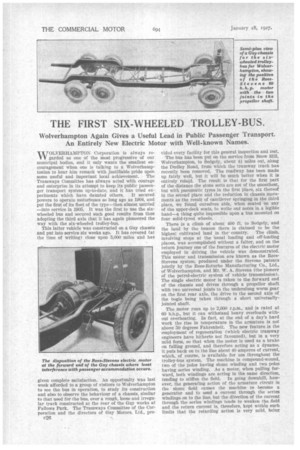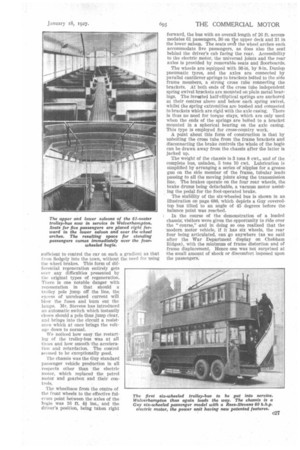THE FIRST SIX-WHEELED TROLLEY-BUS.
Page 48

Page 49

If you've noticed an error in this article please click here to report it so we can fix it.
Wolverhampton Again Gives a Useful Lead in Publie Passenger Transport. An Entirely New Electric Motor with Well-known Names.
WOLVERHAMPTON Corporation is always regarded as one of the most progressive of our municipal bodies, and it only wants the smallest encouragement when one is talking to a Wolverhamptonian to hear him remark with justifiable pride upon some useful and important local achievement. The Tramways Committee has always acted with courage and enterprise in its attempt to keep its public passenger transport system up-to-date, and it has tried experiments which have daunted others. It secured powers to operate motorbuses so long ago as 1904, and put the first of its fleet of the type—then almost untried —into service in 1905. It was the first to use the sixwheeled bus and secured such good results from thus adopting the third axle that it has again pioneered the way with the six-wheeled trolley-bus.
This latter vehicle was constructed on a Guy chassis and put into service six weeks ago. It has covered (at the time of writing) close upon 5,000 miles and has
given complete satisfaction. An opportunity was last week afforded to a group of visitors to Wolverhampton to see the bus in operation, to study its construction and also to observe the behaviour of a chassis, similar to that used for the bus, over a rough, loose and irregular track constructed at the rear of the Guy works at Fellows Park. The Tramways Committee of the Corporation and the directors of Guy Motors, Ltd., pro c26 vided every facility for this general inspection and test.
The bus has been put on the service from Snow Hill, Wolverhampton, to Sedgely, about ft miles out, along the Dudley Road, from which the tramway track has recently been removed. The roadway has been made up fairly well, but it will be much better when it is entirely relaid. The result is that for the first part of the distance the stone setts are not of the smoothest, but with pneumatic tyres in the first place, six thereof hi the second place and the reduction in chassis moveMerits as the result of cantilever springing in the third place, we found ourselves able, when Seated on any of the upper-deck seats, to write our notes in a legible hand—a thing quite impossible upon a bus mounted on four solid-tyred wheels.
There is a climb of about 400 ft. to Sedgely, and the land by the beacon there is claimed to be the highest cultivated land in the country. The climb, involving stops at the Usual loading and off-loading places, was accomplished without a falter, and on the return journey one of the features of the electric motor employed in driving the vehicle was demonstrated. This motor and transmission are known as the ReesStevens system, produced under the Stevens patents jointly by the Rees-Roturbo Manufacturing Co., Ltd., of Wolverhampton, and Mr. W. A. Stevens (the pioneer of the petrol-electric system of vehicle transmission). The single electric motor is taken to the forward end of the chassis and drives through a propeller shaft with two universal joints to the underslung worm gear on the first rear axle, the drive to the second axle of the bogie being taken through a short universallyjointed shaft.
The motor runs up to 2,000 r.p.m., and is rated at 60 b.h.p., but it can withstand heavy overloads without overheating. In fact, at the end of a day's hard work the rise in temperature in the armature is not above 50 degrees Fahrenheit. The new feature is the employment of regeneration (which electric tramway engineers have hitherto not favoured), but in a very mild form, so that when the motor is used as a brake on falling ground, and therefore acting as a dynamo, it puts back on to the line about 40 amperes of current, which, of course, is available for use throughout the trolley-bus system. The machine is compound-wound, two of the poles having shunt .winding and two poles having series winding. As a motor, when pulling forward, both windings are acting in the same direction, tending to stiffen the field. In going downhill, however, the generating action of the armature circuit in the shunt field causes the machine to become a generator and to send a current through the series windings on to the line, but the direction of the current through the series windings tends to weaken the field and the return current is, therefore, kept within such limits that the retarding action is very mild, being sufficient to control the car on such a gradient as that from Sedgely into the town, without the need for using the wheel brakes. This form of differential regeneration entirely gets
over any difficulties presented by the original types of regeneration. There is one notable danger with regeneration in that should a trolley pole jump off the line, the exctess of unreleased current will blow the fuses and burn out the lamps. Mr. Stevens has introduced an automatic switch which instantly closes should a pole thus jump clear, and brings into the circuit a resistance which at once brings the voltage down to normal.
We noticed how easy the restarting of the trolley-bus was at all times and how smooth the acceleratiork and retardation. The control seemed to be exceptionally good.
The chassis was the Guy standard passenger vehicle production in all respects other than the electric motor, which replaced the petrol motor and gearbox and their controls.
The wheelbase from the centre of the front wheels to the effective fulcrum point between the axles of the bogie was 16 ft. 44 ins., and the driver's position, being taken right
forward, the bus with an overall length of 26 ft. accommodates 61 passengers, 30 on the upper deck and 31 in the lower saloon. The seats oyesr the wheel arches each accommodate five passengers, as does also the seat behind the driver's cab facing the rear. Accessibility to the electric motor, the universal joints and the rear axles is provided by removable seats and floorboards.
The wheels are equipped with 36-in, by 8-in. Dunlop pneumatic tyres, and the axles are connected by parallel cantilever springs to brackets bolted to the side frame members, a strong cross tube connecting the brackets. At both ends of the cross tube independent spring swivel brackets are mounted on plain metal bearings. The inverted half-elliptical springs are anchored at their centres above and below each spring 'swivel, whilst the spring extremities are bushed and connected to brackets which are rigid with the axle casing. There Is thus no need for torque stays, which are only used when the ends of the springs are bolted to a bracket mounted in a spherical bearing on the axle casing. This type is employed for cross-country work.
A point about this form of construction is that by unbolting the cross tube from the frame brackets and disconnecting the brake controls the whole of the bogie can be drawn away from the chassis after the latter is jacked up.
The weight of the chassis is 3 tons 8 cwt., and of the complete bus, unladen, 5 tons 10 cwt. Lubrication is simplified by arranging a series of nipples for a grease gun on the side member of the frame, tubular Wads passing to all the moving joints along the transmission line. The brakes operate on the four rear wheels, the brake drums being detachable, a vacuum motor assisting the pedal for the foot-operated brake.
The stability of the six-wheeled bus is shown in an illustration on page 686, which depicts a Guy coveredtop bus tilted to an angle of 45 degrees before the balance point was reached.
In the course of the demonstration of a loaded chassis, visitors were given the opportunity to ride over the "course.' and in doing so one realized that the modern motor vehicle, if it has six wheels, the rear four being articulated, can go anywhere (as we said after the War Department display on Chobham Ridges), with the minimum of frame distortion and of frame displacement. Hence one was not surprised at the small amount of shock or discomfort imposed upon the passengers.












































































































